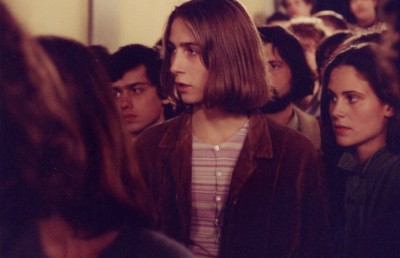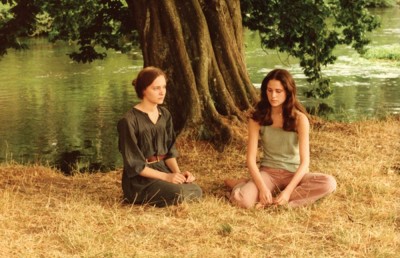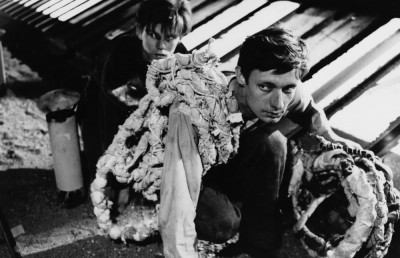Les Dames du Bois de Boulogne: DVD Review
Robert Bresson/DVD Review
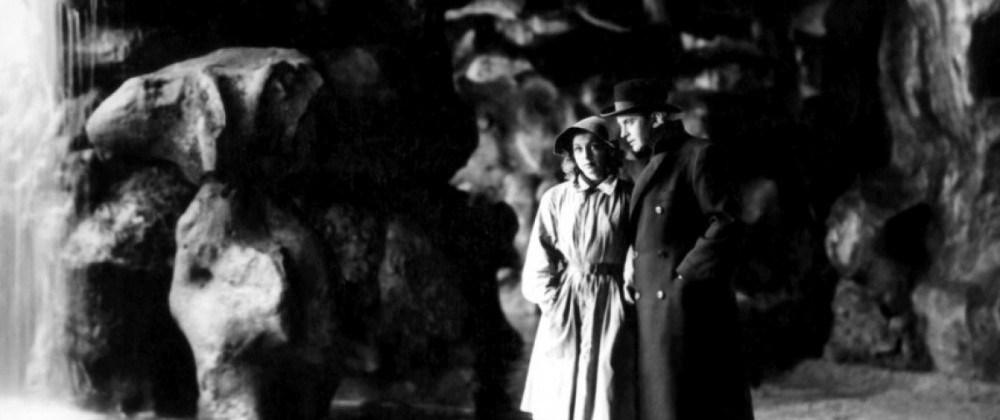
In one of two short essays to be found in the booklet accompanying the DVD of Robert Bresson’s Les Dames du Bois de Boulogne, Francois Truffaut cites Jean Cocteau, dialogue writer for the film, who stated some time after the film’s initial critical and box office failure that it had finally “won its case in the appeals court.” Truffaut marks this as an instance of critics making “amends.” But have they really? The article written by Truffaut was first published on the occasion of a Bresson retrospective in Paris in 1954. I can say without hesitation a half-century later that the film is still on trial, this time with English-speaking critics, and that perhaps this new DVD release will occasion their penitence.
The slightly overdue transfer of Robert Bresson’s films to English-language, Region 1 DVD has finally begun. I say ‘slightly’ in order to counter the overblown impatience of many of those that have awaited this event and been very vocal about it. DVD is still a relatively new technology, after all. Despite this I can’t help but set sobriety aside and agree that there is some measure of injustice and oversight in the fact that certain of the most preposterous and immediately forgettable products of film’s assembly line have been ‘retrieved’ by DVD while, until now, Bresson has not.
Rest assured that, in the next two years, those who admire Bresson’s body of work and who have felt, as a result, that DVD has been a lamentable waste of technology due to the conspicuous absence of one of film history’s most skilled craftsmen will finally find gratification. At stake here are the irritating yet significant issues of accessibility and quality. Seeing Bresson’s films has been a challenge for far too long and for two particular reasons: some of his films have yet to receive video transfers of any kind (Le Procès de Jeanne d’Arc, Quatres Nuits d’un Rêveur), and second and more pointedly, the poor state of the versions that are available. Imagine listening to Mozart on fourth generation cassette. In the absence of anything else, one makes due, but one cannot claim to have encountered the piece in question in the condition that was initially intended. A series of ‘screens,’ both aural and visual, have prevented the kind of clean experience that Bresson’s films so rightly deserve. In short, they need to be ‘unearthed;’ the trying intensity originally ascribed to them must be excavated and permitted to resurface.
I would therefore be remiss not to report the forthcoming tidal wave of Bresson-DVD releases. In fact, speculation abounds on the rumor mill as to which of his films will receive this blessing, in what order and as to the final release dates—visit “robert-bresson.com” for the most recent developments. While some are undoubtedly giddy about the possibilities of this Bresson renascence, sober minds will wonder about quality as much as quantity, particularly when considering Criterion’s Les Dames du Bois de Boulogne DVD. And yet, despite the sour response that the DVD is garnering for the questionable state of the source material from which it was struck, this DVD possesses without doubt a quality of transfer well beyond any of the previous video versions of Bresson’s black-and-white features.
Criterion has been candid about the imperfections of the original print used for the transfer. In response to an inquiry on the DVD’s quality made by robert-bresson.com, Kate Elmore, producer of Criterion’s Les Dames DVD, offers both suitable consolation and a promise:
We too are disappointed with the condition of the film elements for Bresson’s Les Dames du Bois de Boulogne. I can assure you that our digital transfer was done to the same exacting standards as any of our others, but that the existing film elements are in unfortunate shape. What you see on our disc is a an (sic) accurate, reproduction of the image as it survives in duplicate elements. No amount of digital restoration could solve the problems inherent in the material, and, as is our policy in such cases, we refuse to overprocess the image and sound, removing what remains of the character of the original film (grain, texture, depth), simply for the sake of making a “cleaner” picture. Using a fairly light hand, we removed the worst of the dirt, especially around the opticals and reel changes, but there is very little we can do about the softness inherent in the surviving dupes or the shifting (film weave) that commonly results from warping of the reels. As for the sound, we did manage to improve it somewhat, but again, the original sound elements have not been well preserved.
We certainly hope that other film elements, in finer condition, may be found in the future, so that a full film restoration can be undertaken and the picture saved. If nothing else, the flaws inherent in the elements should remind us all of the perishable nature of the medium and of the importance of restoration and preservation efforts. Digital recording is not enough. The celluloid itself needs to be cared for and protected, and in this case, it has not been kindly treated. If something better turns up, as happens from time to time, we will certainly be proud to make it available. But for now, we feel confident that we have made Les Dames look as good as it can, given the state of the film.
Particularly distracting are the speckles that gather at reel changes and the hissing noise perceptible in the film’s first ten minutes. Despite these flaws, the transfer is certainly preferable to the two VHS versions of the film by Home Vision and Hen’s Tooth, respectively.
These technical considerations aside, a closer look at the film itself reveals that the selection of this film as opposed to any of the director’s other masterworks was a sound one and perhaps for reasons that the distribution company was not aware.
Paul Schrader’s ‘theory of transcendental style,’ a euphemism for what is scarcely more than a religious interpretation flimsily heaped upon stylistic elements detected throughout Bresson’s oeuvre that implicitly relies upon the ‘spiritual’ themes of the filmmaker’s Prison Cycle for certification, finds its antidote in Les Dames. This film is evidence that Bresson’s style suitably matches themes that are by nature ‘material,’ or this worldly, and as such, not interested in matters of ‘transcendence.’ In addition, we are reminded, thanks to the DVD release, that this is a film well worth considering as mature Bresson and not simply as a minor curiosity by virtue of its lack of ‘otherworldly’ invocations. Permit me to digress a moment.
To a stunning degree and to a point which few seem aware, Schrader’s theory, and Susan Sontag’s essay, “Spiritual Style in Film” as well, has cast a spell over English-language Bresson scholarship for in excess of 30 years. The result, perceptible in recent writings on Bresson by Keith Reader and Joseph Cunneen, to name but two noteworthy instances, has been the relegation of Les Dames to the category of films sign-posted “Bresson before Bresson.” Stated otherwise, by virtue of critical complacency, it has become generally accepted that the 1944 film is the product of a filmmaker in his creative adolescence. Naturally, if by “mature Bresson” one means to refer to an artist whose developed style is purportedly reminiscent of that of anonymous Byzantine icon painters, that is, concerned with inducing religious belief, then the categorization of Les Dames as an early or minor work would seem to follow. Schrader is so convinced that this is the raison-d’être of Bresson’s work that he discards Les Dames as a production in which the filmmaker was “somewhat at odds with his material.” The only support that is offered for this claim is the religious biases evident in the theory itself. In any event, for those of us who acknowledge Bresson as a gifted and influential modernist artist working as he did with a 20th Century medium and responding to uses of it that he found inadequate, then this fashionable dismissal of Les Dames does not seem so justifiable.
To end my digression, I would state only that the theory of transcendental style misleads and thatLes Dames, for reasons we will shortly discuss, brings this to light. In the end, the theory encourages the interested spectator not to look at the films empirically. Its neglect of the context from which their maker emerged and in which he honed his craft makes it possible to consider Bresson’s stylistics on uniquely ‘theological’ or “universal” terms. Consideration of context, then, brings us closer to the style of the films themselves than any kind of garrulous ‘theorizing’ about spirits and phantasms of universality.
Style, film style, discussed here in accord with David Bordwell’s use of the term, does not develop sui generis, even for a film artist as original as Bresson. The roots of his modernist style grew in resistance to the stylistics of the literary adaptations that dominated French cinema in the period running from the 30s to the 50s. Nowhere is this on better display than in Les Dames, a film marked more by concerns specific to the medium than by fidelity to the original source from which it was adapted.
Despite the demands it makes upon audience concentration and sympathy, the film’s narrative, taken from Denis Diderot’s Jacques le Fataliste (unread by me), is a rather uncomplicated revenge tale. Hélène, played with calculated moderation by Maria Casarès, believes she can control destiny. Sensing that she’s in love with a man (Jean) who no longer loves her, she sets a trap for him in one of the film’s opening scenes—one that will set the tone for the rest of the film. In admitting that her love for him has cooled, she conceals her intentions and feelings while coaxing him to reveal his: his love for her has cooled as well. This disclosure, accompanied by a sigh of relief by Jean and, we sense, a long time in the making, sets Hélène’s plan into motion. She will arrange a union between him and a woman of lowly repute, by 18th Century French standards anyway, whom Hélène intends to hand pick. Jean’s social ruin is what she has in mind. The woman for whom Jean is to fall, an innocent country type brought to the city by her hopes of fame, is a promiscuous cabaret dancer named Agnès, rendered here by Elina Labourdette. We find out that Hélène had had some dealings with Agnès and her caring if simple-minded mother, Madame D, in the past, but that Hélène had not visited them in quite some time. (Madame D suspects, probably accurately, that they had not received her recently by virtue of the financial peril they had lately experienced.) Unaware of the exact intentions behind her actions yet suspecting the worst, we watch as Hélène ‘coaches’ the desperate Agnès and her mother back to what they believe will be financial security and social acceptance (all for the benefit of Agnès’ dancing career).
Thus Hélène councils them to retreat from public life—she will care for them and support them in the interim. Of course, as we shortly deduce, she has insisted upon their seclusion in order to suspend Agnès’ ‘activities’ as a glorified courtesan, if only temporarily. She wouldn’t want Agnès’ escapades to jeopardize the intrigue already sparked in Jean, who will undoubtedly seek Agnès out and pursue her when and where he can.
Hélène is ambitious. She not only seeks to manipulate Agnès and Jean by engulfing them in the bubble of romantic intrigue, orchestrating their daily affairs all the way down to scheduling public appearances (Agnès and her mother become known to Jean as “Les Dames du Bois de Boulogne” after having an ‘impromptu’ meeting with them in the Parisian park), but she wants to mold and focus the opinion of the Parisian upper crust as well. Aware that Agnès’ questionable character and a love affair between the two could never remain ‘private’ due to Jean’s social standing, Hélène charts courses for each of these unsuspecting souls.
As with many Bresson films, the sting is in the very tip of its tail. In the final act, Hélène, possessing an evil sense of timing, plants suspicion in Jean as to Agnès’ true social status while taking her turn in the receiving line moments after Jean’s and Agnès’ marriage. “I’m afraid I was completely wrong about that girl,” she whispers to him loud enough to ensure than Agnès hears as well. On that same night, Jean, sensing the magnitude of his ruin and unwilling to console his weeping bride, leaves his own wedding reception. On his way out, he hits another car just pulling in. Stepping out of this other car is Hélène, who with a devilishly calm sneer saunters over to Jean and reveals all. She had orchestrated the entire affair and, twisting the blade a little further, reminds him that, at present, his reception is attended by numerous men who had each had the pleasure of ‘consoling’ Agnès at some point or other (neatly accompanied on the soundtrack by men laughing). Jean zooms off in silence.
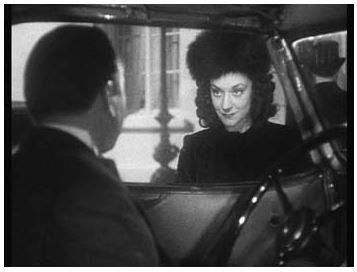
But Hélène had created something that far outreaches even her control; her victory over Jean and at the expense of Agnès is but a Pyrrhic one. The film ends with Jean returning home to find his bride ill and at the care of her mother. In this, the film’s final scene, with all concern for social standing rendered irrelevant, Jean declares his unconditional love for his ailing wife. The words spoken by Michel to Jeanne in Pickpocket, released 14 years after Les Dames, would certainly apply here: “O Jeanne, in order to get to you, what a strange path I had to take.” Hélène’s revenge cuts a path that brings Jean to Agnès.
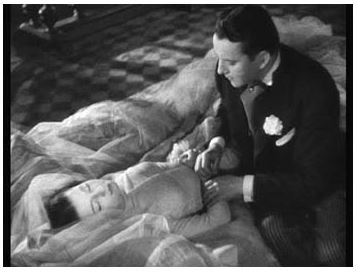
How this tale is told is what elevates it to levels beyond its scope. “Le Journal d’un Curé de Campagne: The Stylistics of Robert Bresson,” first published in Cahiers du Cinéma in 1951, remains to this day one of André Bazin’s greatest accomplishments, beyond being one of the most sound essays ever written on Bresson. Bazin characterizes Bresson the stylist as a “corruptor,” not only of Diderot’s original material, but of the art of the cinema as well. Thus—and this is the crux—the article does not exclude Les Dames from its discussion of Bresson’s style.
Les Dames’ corruption of film’s conventional techniques begins at the level of performance. Bresson’s famed insistence upon restrained expressivity—that his models or actors do not ‘project’ their innermost feelings—takes on added significance, even if we have it only in a moderate dose here. Portrayed in the film is a society whose members are strangled by the opposing pressures of personal desire and public decency or formality. The slightest misstep is potentially disastrous. By granting the actors only rare moments of physical release and demanding for the balance relative self-control, Bresson has molded the film’s main performances into a subtle commentary on a series of characters who teeter on the edge of (self-) exposure.
The characters themselves, in the desires and wishes that they prevent from surfacing in their daily affairs, must perform, but not in the sense one would suspect. In a characteristically Bressonian paradox, they perform by, for lack of better phrasing, performing non-performances, by holding their faces straight, thus giving those with whom they are interacting little to ‘read.’ And because this acts as a preventative measure, ensuring that others around them do not suspect their true intentions, it behoves these main characters to uphold their ‘performances.’ Agnès, as Jean’s object of pursuit and due to her indebtedness to Hélène, must curb her enthusiasm for her wooer. Demands are also placed upon Jean, who must take care not to come on too strong and smother this mysterious “dame.” And Hélène, as the puppeteer, can show her true self to no one, for in her eyes, restraint is a guarantor of revenge. What I am suggesting here is that these characters adopt some of the peculiar idiocyncracies of Bressonian models because conditions in the narrative call for it. Thus, throughout this tangled web, we get brief glimpses of who these characters are and then extended ones of who they are required to be. And it seems as though Hélène’s success at the manipulation of others is due to her convincing (non-) performances and to the manner in which she coaches others in theirs. This give-and-take between subtle expressivity and noticeable restraint makes this film perhaps one of Bresson’s most gratifying in terms of performance.
This, naturally, is not to say that Bresson’s actors here do not ‘project’ in some measure. Les Dames is one of few films in which our filmmaker employed professional actors and is perhaps the film in which he decided, due the conflict between he and Casarès, that trained performers could or would not give him the restraint that he was looking for. Casarès’ predilection for leaning on objects, for slouching on a mantle in a scene early in the film in which she sneers at Jean as he falls innocently into her trap, does not seem to be one of Bresson’s touches.
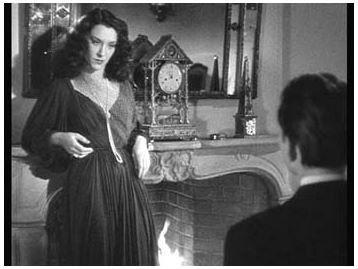
But consider the richness of these performances closer—they furnish us with several layers of character. Casarès’ Hélène isn’t always smirking and gloating under her breath. The wedding ceremony sees another Hélène come to the surface. As Jean moves down the aisle behind Agnès, the camera tracks past Hélène, who stands in a pew among other invitees. This is unquestionably the most beautifully composed image in the film and the shape of Casares’ performance is central to it. We first glimpse the bride and groom marching slowly toward the altar, accompanied by the gentle tones of an organ. The camera then moves off toward and isolates Hélène, who, with eyelids shut and crying, is eventually relegated to the background of the shot as Agnès and company fill the frame again and the camera continues its methodical crawl down the aisle. As Agnès passes Hélène, we can’t help but be prodded to contrast these two women. Agnès, oblivious and elated, glows with happiness, smiling in her white gown. Hélène, on the cusp of seeing her plan unfold, is miserable and alone, wearing black from head to toe as if she were attending a funeral. Bresson has squeezed the essence out of this short segment and could not have accomplished this without the restraint and focus of his actors, particularly Casarès who, in terms of facial expression and timing, remind one of Anne Wiazensky’s Marie in Au Hasard Balthazar. An arrogant and smirking Hélène would have ruined this shot and the character and the film would have been lesser for it. Bresson’s and Casarès’ head butting seems to have paid off, weaving an intricate character tapestry.
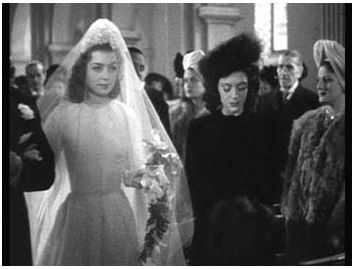
Bresson’s narrative is told with the kind of thriftiness that we would expect. Segments are cut almost in mid-sentence; the space between segments carries weight on par with those of the segments themselves; and no segment is superfluous. We are presented with a narrative skeleton and asked to fill it in with flesh and organs. When Hélène first visits Agnès and Madame D at their sparsely furnished apartment and Hélène informs the mother that she will furnish the means for their social and financial restoration, Madame D rushes to tell Agnès, who had locked herself in her room. Instead of showing the exchange between mother and daughter, Bresson grants us only a glimpse, giving us just enough information. We don’t need to see Agnès’ reaction to the news, Bresson would probably contend, and so the segment abruptly ends with Madame D calling her daughter, “Agnès! Agnès!” This method for ending a segment, of hinting at a conversation that we never actually see, is one for which Bresson would become fond.
More significantly—and daringly—as viewers we are left totally to our own imagination to fill in the gaps of the film’s ending. What happens between the time that Jean leaves the wedding reception in his car and the time that sees his return, where he ‘suddenly’ demonstrates his true love for his bride? How much time has elapsed? How and when does he decide that his social standing means less than his love for Agnès? Under what pressures, after how much soul-searching, does plain enthralment for a woman blossom into self-sacrificing love? Textually, all we are given is a fade to black, but what are we to make of it?
Bresson’s emphasis on the ends at the expense of the means here makes the narrative tighter and its climax unexpected and forceful. These questions, the director would seem to say, are peripheral, as is any concern for what happens to Hélène. Another, lesser filmmaker would have ended the film by showing Hélène wallowing in loneliness and misery, meditating over the failure of her grand scheme. This makes sense, does it not? After all, the film started with Hélène and it is her story, right? Why not end it with her in order to give the narrative a sense of symmetry? Bresson’s decision not to do this defies conventional logic and is an important statement about the incommensurability of A+B=C logic and aesthetic ‘logic’ or dramatic completeness.
In these ways and others, Bresson has made a film that is just as challenging and polished as any of his so-called ‘middle’ and ‘later’ works, but that manages to maintain its own distinctness in the body of work as well. Space permitting, for instance, we could spend some time analyzing one of the film’s unique compositional strategies: the subtle use of blurred objects like door frames and railings in the foreground to foreshadow actor movement within the frame, with characters moving toward these objects as scenes or individual shots complete themselves.
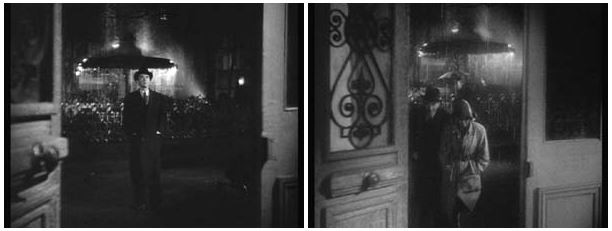
This careful attention to camera position and staging, perhaps commenting on the socially ‘programmed’ motions of these unsuspecting characters, is of a style to be seen nowhere else in Bresson’s oeuvre. Critics should not feel the need to suffocate this distinctness just because it either calls their critical constructions into question or treats them with relative indifference. Theories of art, as emanating from the city of the secondary and as primarily concerned with ‘discovery’ or ‘seeing’ rather than ‘interpretation’ or ‘making,’ must shape themselves around the art and avoid forcing the art to shape around them, otherwise theories are indistinguishable from fantasies. Criterion’s timely release of Les Dames presents disciples of the theory of transcendental style with ample reason for making amends for their critical fantasizing.
The Criterion DVD also includes the following:
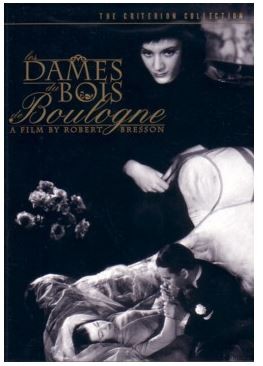
•[b]Audio:[/b] French (Dolby Digital 2.0 Mono)
•[b]Subtitles:[/b] English (removable)
•[b]Aspect Ratio:[/b] Full Screen (Original Aspect Ratio)—1.37:1
•[b]Edition Details:[/b]
• New digital transfer, with restored image and sound
• New and improved English subtitle translation
• Still gallery featuring rare behind-the-scenes photos—18 shots of Poster, Bresson and cast
• Essays by Francois Truffaut and David Thomson—4 pages of linear notes



